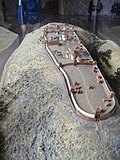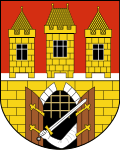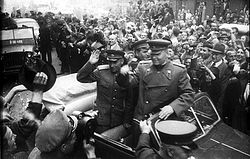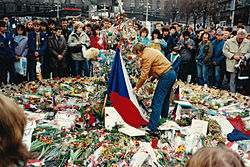Prague
Prague (Praha in Czech) is the capital and the largest city of the Czech Republic. 1.4 million people live there.
|
Praha | |
|---|---|
Capital city | |
| Hlavní město Praha | |
 | |
|
| |
|
| |
 | |
| Coordinates: 50°05′N 14°25′E / 50.083°N 14.417°ECoordinates: 50°05′N 14°25′E / 50.083°N 14.417°E | |
| Country | |
| Founded | c. 885 |
| Government | |
| • Mayor | Zdeněk Hřib (Czech Pirate Party) |
| Area | |
| • Urban | 496 km2 (192 sq mi) |
| Highest elevation | 399 m (1,309 ft) |
| Lowest elevation | 177 m (581 ft) |
| Population (2015-12-31)[3] | |
| • Capital city | 1,391,508 |
| • Metro | 2,156,097 [2] |
| Time zone | UTC+1 (CET) |
| • Summer (DST) | UTC+2 (CEST) |
| Postal code | 100 00 – 199 00 |
| Vehicle registration | A |
| NUTS code | 2012 |
| - Total | €40 billion |
| - Per capita | €32,000([1]) |
| Website | praha.eu |
| Statistics statnisprava.cz | |
Prague has been known as one of the most beautiful European cities since the Middle Ages. It is often called the "City of 100 Towers", the "Rooftop of Europe" or the "Heart of Europe." Prague was a place where many merchants, artists and inventors met.
Prague is full of historical monuments in all major artistic styles. The historic center of Prague is on both banks of the Vltava river. This historical center has six districts, which were once independent cities that joined in the 18th century. These districts are Staré Město (Old Town), Pražský hrad (Prague castle), Josefov (Old Jewish Town), Nové Město (New Town), Malá Strana (Lesser Town), Hradčany (Prague Castle Quarter) and Vyšehrad. It was Prince Bořivoj who established Prague Castle. There are also lots of museums, galleries, theaters, concert halls, and other historic buildings.
History
The earliest inhabitants of the area lived in the valley of the Vltava river around 500 BC. Slavonic tribes came to Bohemia in about 500 AD. There is a legend about how the town of Prague started. Princess Libuše, the leader of a Slavonic tribe, chose a simple peasant Přemysl to be her husband. She told him to go and find a village on the banks of the Vltava and to start a town there. The town became Prague, ruled by the Přemyslid family.
In the second half of the 9th century the castle’s original fortifications were built. During the reign of Wenceslas I (Václav in Czech) in the 10th century the church of St Vitus was built at Prague castle. Wenceslas was murdered by his brother when he was going to church. He was later made a saint. In the early 11th century the Přemyslid family got power in Moravia, too. Vratislav II was the first monarch to be called King of Bohemia.
Another ruler, also called Wenceslas I, ruled as King of Bohemia from 1230. He encouraged the arts. Many Germans came to live in Prague. In 1257 King Otakar II founded the area of Prague called the Lesser Quarter for the Germans to live in. The last of the Přemyslid kings was King Wenceslas III. He was murdered in Moravia.
During the Middle Ages Prague became very important as the capital of the Holy Roman Empire ruled by Charles IV (1316-1378) who was the most powerful ruler in Europe at the time. Charles made Prague a great city, building St Vitus Cathedral, a university, and a famous bridge called Charles Bridge which still exists.
After Charles IV there were many arguments and fights in Prague. A priest called Jan Hus said that the Catholic Church had become too powerful. He was arrested and burned at the stake in 1415. A lot of people agreed with what Hus had been saying. These people were called Hussites. They threw a lot of important Catholic people out of the window (called "defenestration"). A lot more fighting followed, and for many years Bohemia was ruled by kings who lived in other countries.
From 1526 the Habsburg family ruled Bohemia. They were Catholics and ruled the Holy Roman Empire. In 1576 the Emperor Rudolph II moved the capital from Vienna to Prague. Prague became a rich town again, and people were free to worship as Catholics or Protestants. After Rudolph II there were a lot of religious fighting and more people were thrown out of windows. Eventually the fighting became part of the Thirty Years’ War. When Ferdinand II won the fighting a lot of Protestants left the country. New buildings in Prague were built in the Baroque style. The German language, not Czech, was spoken at court. Maria Theresa was the only queen to reign over Prague. One of her 16 children was Marie Antoinette who became queen of France. When her son Joseph II ruled, people stopped fighting about religion. The people were free to speak what they thought, and there was no more serfdom. Prague now had three parts: the Old Town, the Lesser Quarter and the New Town. Famous people such as Wolfgang Amadeus Mozart visited the town often.
In the 19th century industry came to Prague. Factories were built, a railway was built between Prague and Vienna. The Czech nationalist movement became very strong after 1848. They wanted to use their own language instead of German. The composers Smetana and Dvořák wrote music about their country, often using Czech folksongs. The National Theatre was opened in 1881.
In June 1914 the Archduke Franz Ferdinand, heir to the Habsburg throne, was murdered. This led to World War I. After the war an independent republic called Czechoslovakia was formed with Prague as its capital. Bohemia, Moravia and Slovakia were part of it. In 1938 Hitler invaded the country. It was liberated by Soviet troops in May 1945. However, the communists soon seized power and the country was ruled by communists who had to obey the Soviet Union. The prime minister Alexander Dubček gradually tried to make reforms. This period of time is called the "Prague Spring". In 1968 the Soviet Union sent tanks into Prague to Wenceslas Square to restore their power.
Democracy gradually came to Prague in 1989 when the Velvet Revolution happened. In 1993 the Czech Republic and Slovakia split into two countries. Today both these countries are part of the European Union.
Cultural sights
Since the fall of the Iron Curtain in 1990 Prague has become one of Europe's most popular tourist places. It has buildings dating from the 13th century to the present day. The castle looks very important on the hillside. Charles Bridge is now closed to traffic so that pedestrians can walk across the bridge and buy souvenirs from the stalls. There are many museums, palaces and theatres. Tourists often go to the Old Town Square in the centre of Prague. There are lots of buildings there from different periods of history. The statue of Jan Hus stands high above the square. There is a famous Astronomical Clock on the wall of the Old Town Hall. There are museums dedicated to famous people including Smetana, Dvořák and Franz Kafka. The Estates Theatre is one of Europe’s oldest theaters. It was built in the 1780s and Mozart conducted the first performance of his opera Don Giovanni there.
Prague is on the list of World Heritage Sites.
Economics
Prague has been important in the economy of what is now the Czech Republic since the region developed industry in the 19th century. Textiles and machinery are made and exported to many countries. Food, electronics and chemicals are produced. Nearly half the people who work are women.
Prague is becoming a city where many international companies have their headquarters. Since the late 1990s, Prague has become a popular filming location for international productions and Hollywood motion pictures.
There are no ghettos in Prague.
Colleges and universities
The city contains several universities and colleges including the oldest university in Central and Eastern Europe: the Charles University, founded in 1348.
Transport
Prague has three metro lines, 20 tram lines, and buses that connect to the suburbs. There is also a funicular rail link to the top of the Petřín Hill and a chairlift at Prague Zoo. All these services have a common ticketing system.
Prague metro is one of the best in Europe for quality and speed. It has got 3 lines (A, B, and C), 65 kilometers and 61 stations.
Trains from Prague connect to major cities in neighbouring countries.
There is a modern airport, Václav Havel Airport Prague, used by many airlines including Czech Airlines.
Sport
Prague has many parks and gardens, including a park for culture, sports and entertainments which is named after Julius Fučík, a resistance leader of World War II. It has three stadiums, the largest of which, Spartakiádní stadion, holds 250,000 people. They have a good Soccer team and play many sports.
Prague Media
The mythological princess Libuše prophesies the glory of Prague.
A model representing Prague Castle and its surroundings in the 10th century
The current St. Vitus Cathedral in Prague was founded in 1344.
The Prague astronomical clock was first installed in 1410, making it the third-oldest astronomical clock in the world and the oldest one still working.
The coat of arms of Prague (1649)
Monument to František Palacký, a significant member of the Czech National Revival, created by Stanislav Sucharda
Statue of Tomáš Garrigue Masaryk near Prague Castle
The Red Army enters Prague in May 1945.
References
- ↑ "Demographia World Urban Areas" (PDF). Demographia.com. Retrieved 18 November 2013.
- ↑ Van Ermengem, Kristiaan. "Prague Facts & Figures, Population". aviewoncities.com. Archived from the original on 22 December 2015. Retrieved 7 April 2016.
- ↑ "Nejnovější údaje o kraji" [Latest data on the region]. Regional Office of the Czech Statistical Office in the Capital City of Prague (in čeština). 17 October 2014. Retrieved 7 April 2016.
Other websites
| Wikimedia Commons has media related to Lua error in Module:Commons_link at line 62: attempt to index field 'wikibase' (a nil value).. |
- Official Website Archived 2004-03-20 at the Wayback Machine
- WorldFlicks in Prague: Photos and interesting places on Google Maps Archived 2008-02-26 at the Wayback Machine


















